First Drive: 2023 INEOS Grenadier in Scotland
There’s been an inexorable softening of the all-terrainer genre over the past couple of decades, as most contenders in the category have chased cushy ride quality and car-like handling at the expense of mud-mauling, boulder-conquering heroics.
Body-on-frame vehicles reducing
You can virtually count on one hand the number of off-roaders today that have retained robust body-on-frame construction and a beam axle supporting at least one end of the vehicle. Only the Jeep Wrangler has adhered to the original 1940s recipe, with its meaty ladder-frame chassis and solid axles front and rear. In contrast, the likes of the Toyota LandCruiser 300 Series, Mercedes Geländewagen (aka G-Class or G-Wagen) and various American SUVs – such as the Chevy Tahoe and Ford Expedition – have stayed largely true to their roots, despite gaining a host of electronic doodads and independent front suspension in recent years.
However, the Land Rover Defender – which for 67 years had continued the lineage of its 1947 ancestor – adopted a wholesale change of philosophy in 2019 as the all-new iteration (L663) ditched its trademark blue-collar recipe in favour of a formula that targets cashed-up urban warriors over off-road enthusiasts and working folks who need to venture far off the beaten track. Gone are the original Landy’s body-on-frame construction and rugged beam axles, replaced by a monocoque chassis, independent front and rear suspension and more electronic gizmos than the Space Shuttle.
Every cloud has a silver lining, and the demise of the old and arguably “true”, Defender is what paved the way for the Ineos Grenadier – an all-new offering built by a company that had never previously dipped its toes into the automotive domain, except as a sponsor of the Mercedes-AMG Formula One team.
Ineos history
Some quick background: Ineos is the fourth largest chemical company in the world, generating an annual revenue of $65 billion and employing 26,000 people worldwide. The Grenadier is the brainchild of Ineos founder and CEO Sir Jim Ratcliffe, who envisioned a spiritual successor to the Defender that would reprise the essence of the iconic British off-roader while harnessing the best technology available today.
Sir Ratcliffe said the idea behind the Grenadier was “to develop a 4X4 that will be an uncompromising, no-frills, no-fuss vehicle that provides the best-in-class off-road capability, durability and utility. It will support those who depend on a vehicle as a working tool, wherever they are in the world.”
The first technology partner Ineos enlisted was the highly respected Austrian automotive engineering firm Magna Steyr, which played a key role in co-developing the Grenadier from its inception to the prototyping stage. The development phase took five years, and prototypes completed 1.8 million kilometres of testing in extreme conditions ranging from the Schöckl Mountain to the punishing sands of the Sahara.
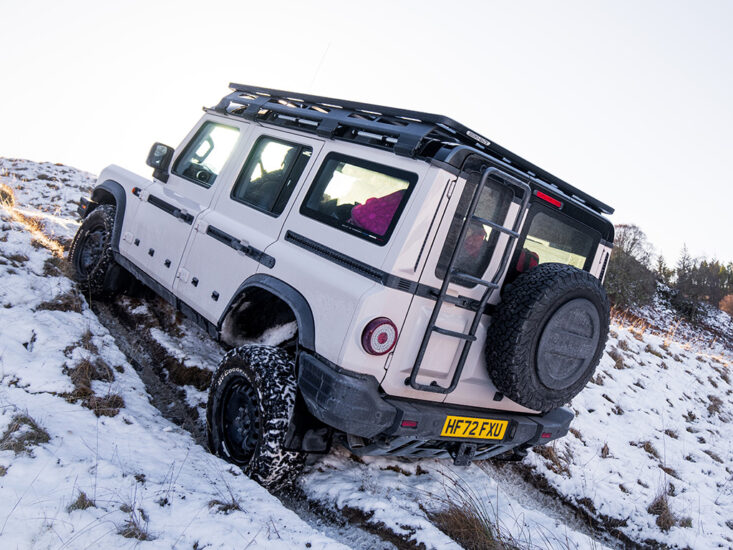
Although the final assembly of the Grenadier takes place in an ex-Mercedes-Benz plant in Hambach (a small French industrial city located within a 20-minute drive of the German border), the building blocks of the vehicle are sourced from all over the globe.
Italian tractor specialist Carraro supplies the rugged beam axles, the two-speed transfer case is built in Mexico by Tremec, the steel ladder-frame chassis is made in Germany by Gestamp, while the body panels (all steel, apart from the aluminium bonnet, doors and tailgate) are stamped in Austria.
Ineos Grenadier engines supplied by BMW
Ineos turned to BMW for propulsion, and the Grenadier’s two powertrain choices are a 3.0-litre six-cylinder turbo petrol unit (B58) and a 3.0-litre turbodiesel (B57). Both engines have been remapped to deliver strong pulling power low in the rev range.
As a result, the petrol motor ekes out its 286hp max output at just 4,750rpm, while peak torque of 450Nm comes on tap at a barely idling 1,700rpm. The diesel is even more of a grunter, pushing out 249hp at a leisurely 3,250rpm and liberating a barrel-chested 550Nm from just 1,250rpm. Both BMW-sourced engines are hooked up to the same ZF eight-speed auto you’d find in an X5, and even the gear lever is identical to the one you’d find in a BeeEm.
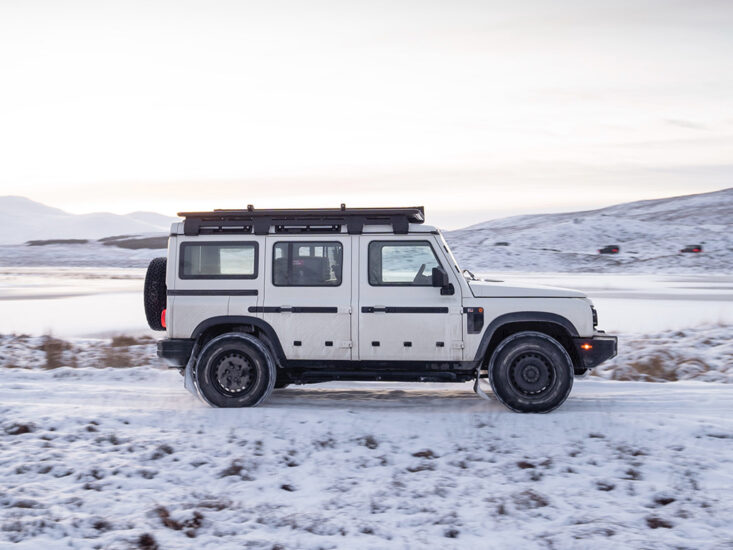
Deliveries of the Grenadier are expected to commence at the end of Q1, with the initial model line-up comprising a no-frills entry-level offering plus the more generously equipped Trialmaster and Fieldmaster. The base model will cost from Dh267,000, while the latter two will be pegged at Dh299,000.
The key difference between the Trialmaster and Fieldmaster is that the former is more off-road oriented, while the latter focuses more on luxury. Consequently, the Trialmaster is equipped as standard with electronic front and rear diff locks, 17-inch steel wheels, BF Goodrich All-Terrain T/A KO2 tyres and a raised air intake. The more cossetting Fieldmaster instead gets alloy wheels, leather trim, heated front seats and various other niceties.
Ineos Grenadier driving impressions
Our first taste of the Grenadier takes place in Scotland, where the Ineos events team has mapped out a route that will take us from Inverness to Glasgow via the uplands of Drummossie Muir, the open expanses Dava Moor and then through the spectacular Ardverikie Estate, which has served as a filming location for several blockbuster movies, including the latest James Bond thriller, No Time to Die.
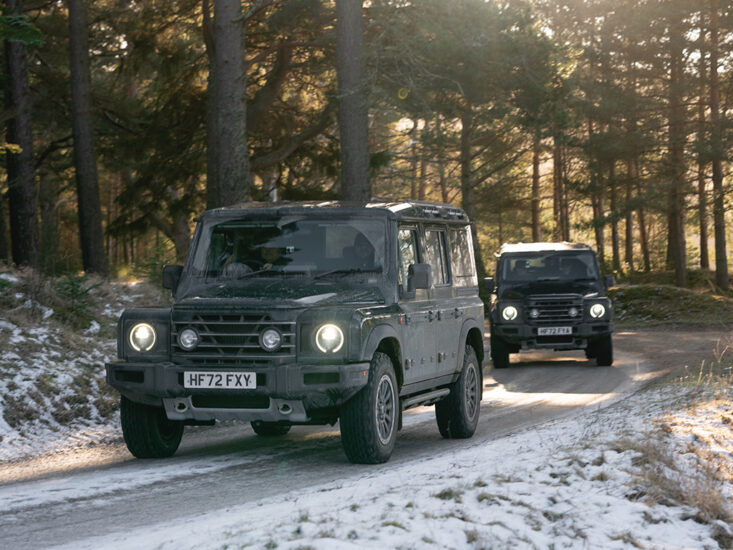
After an overnight stop at the Kingshouse Hotel, we venture further south, with fast, sweeping roads carrying us around Loch Fyne and finally to Loch Lomond, one of the UK’s largest expanses of open water.
You may, at this point, be thinking the Grenadier has more than a passing resemblance to the old Defender, and the top brass at Land Rover thought so too. However, in 2020 a UK court ruled against JLR (Jaguar Land Rover) in their bid to get the trademark rights for the shape of the Defender, so Ineos is totally within its rights to sell the Grenadier in its current form.
Enough of the preamble. First impressions on hitting the road – initially tarmac – in the Grenadier is that it feels remarkably refined for what it is. Yes, it’s underpinned by a 3.5mm-thick steel ladder-frame chassis and beam axles, yet it rides with impressive suppleness. Credit here goes to the five-link suspension setup with coil springs at the front and rear (there’s no air suspension option).
And despite its boxy profile, which wouldn’t be much slipperier through the air than a barn door, there isn’t an excess of wind noise from around the A-pillars. Quite the opposite, so you could certainly envision crossing continents without having your spine pummelled and eardrums battered.
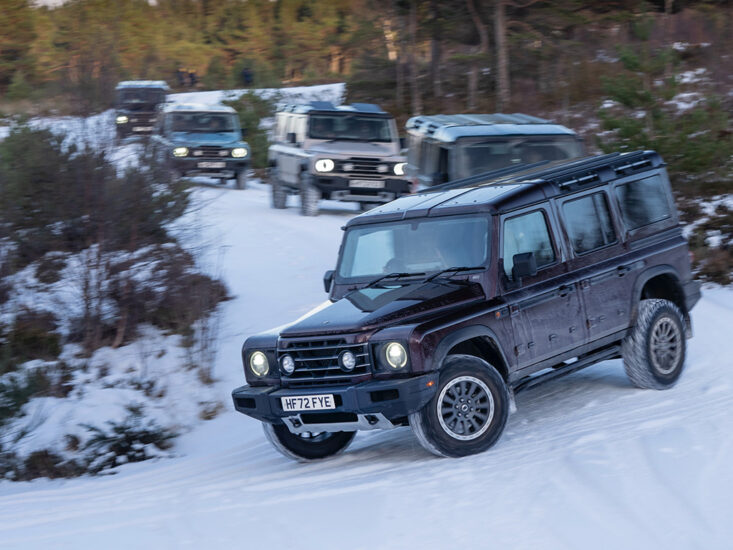
The only factor that slightly compromises the Grenadier’s on-road demeanour is that the Bosch-supplied recirculating ball steering has 3.85 turns from lock to lock, which necessitates copious wheel twirling to get the vehicle rotated through tight turns and roundabouts. There’s also a vagueness to the steering around centre, so the Grenadier isn’t the most effortless or relaxing vehicle to thread across narrow tarmac roads.
Interior layout
The cabin layout is simple and functional and has a distinctly analogue feel, with an abundance (but not an excess) of physical knobs and switches for the major controls. Personally, I much prefer this approach to the touchscreen bonanza that has become ubiquitous of late. I find nothing more annoying than having to scroll through several menus simply to adjust the HVAC settings.
The centre console is dominated by the two-speed transfer-case lever, which is topped by what looks like a pool 8-ball. You lift the collar around the shaft, pull the lever back to engage Low Range, and then slot it to the left to lock the mechanical centre differential.
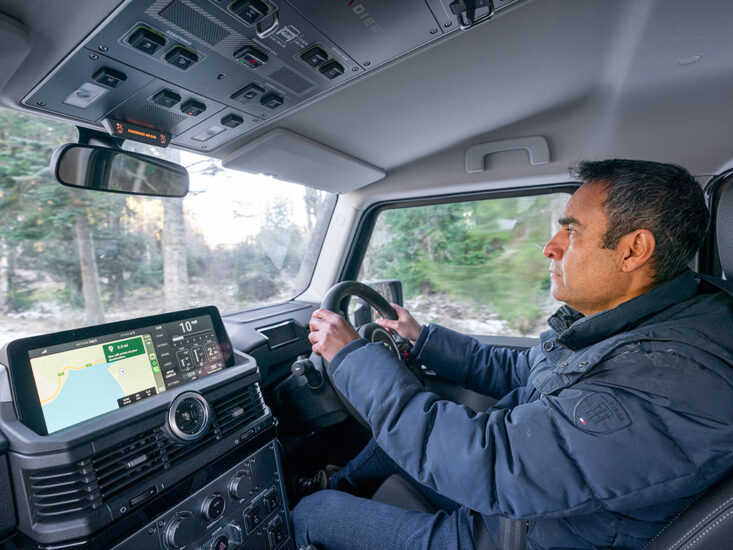
There are additional switches on the aircraft-inspired roof console to engage the electronic front and rear locking diffs, plus a button for Offroad mode, which deactivates auto stop/start and the park sensors, as well as loosens up the ESP and traction control. The only element in the Grenadier’s cockpit that looks out of place is the transmission lever for the ZF eight-speed auto, which is exactly the same as the one you’d find in most BMWs these days.
The overriding impression is that this is a no-nonsense vehicle that’s built for purpose – i.e. going off-road – yet there are still enough soft-touch materials and a quality ambience (especially in the Fieldmaster) to make the cabin a welcoming place.
The Recaro seats are superbly contoured, but the door pockets, glovebox and centre storage compartment are all on the small side. Another niggle is that there’s only one grab handle (on the front passenger side) to hoist yourself into the vehicle. The Ineos design team opted against fitting one on the driver’s side as they felt it impinged forward visibility. No problem if you’re a sprightly spring chicken, but it’s not ideal for older folks with limited mobility.
Ineos Grenadier off-road capability
There’s no faulting the Grenadier’s off-road credentials. With 264 mm of ground clearance and approach and departure angles of 35.5 and 36.1 degrees, respectively, it can walk across most obstacles with relative ease. Over two days of traversing mud, ice and rocks, the only time our vehicle needed a yank was when I inadvertently put the left wheels in a deep rut that was concealed by snow cover.
The beam axles provide generous wheel articulation, while the lockable diffs enable the tyres to find traction even when one or two wheels are off the deck. It’s also worth noting that the Grenadier can tow up to 3.5 tonnes and has 5.5 tonnes of winching capacity to haul itself or another vehicle out of trouble.
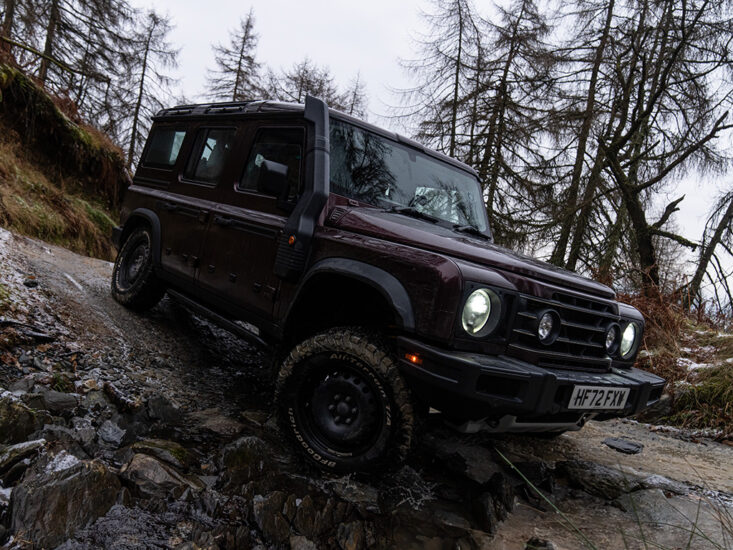
One of the most interesting sections of our off-road excursion was a steep muddy descent that was best tackled by engaging Downhill Assist, which brakes individual wheels to keep speed down to the desired level. With this feature enabled, you can pretty much take your feet off the pedals and focus solely on picking the optimum line down narrow, obstacle-strewn tracks.
The brakes, developed with Brembo, are comfortably up to the task as the Grenadier has 316 mm vented front discs gripped by twin-piston calipers, while the 305mm rear solid discs are actuated by single-piston calipers.
Overall, the Grenadier comes across as a highly impressive off-roader, especially considering Ineos has no history as an auto manufacturer. The Grenadier’s build quality is impeccable, and the vehicle does exactly what it says on the tin. There’s nothing pretentious about it, unlike many so-called all-terrainers these days.
The five-door wagon is just the beginning, as Ineos will roll out a dual-cab pickup and cab chassis later this year, and a battery-electric vehicle is due in 2025.
THE SPECS – INEOS GRENADIER
Engine: 3.0-litre six-cylinder turbo petrol (B58); 3.0-litre six-cylinder turbodiesel (B57)
Power 286hp at 4750rpm (petrol); 249hp at 3250-4200rpm (diesel)
Torque 450Nm at 1750-4000rpm (petrol); 550Nm at 1250-3000rpm (diesel)
Transmission ZF eight-speed auto
Chassis/Suspension: Steel ladder-frame chassis; solid beam axles and coil springs front and rear
Length 4896mm
Width 1930mm
Height 2036mm
Wheelbase 2922mm
Front overhang 887mm
Rear overhang 874mm
Ground clearance 264mm
Approach angle 35.5 degrees
Departure angle 36.1 degrees
Ramp-over angle 28.2 degrees
Wading depth 800mm
0-100kph 8.6sec (petrol); 9.9sec (diesel)
Top speed 160kph
Fuel tank 90 litres
On sale End of Q1
Price: From Dh267,000 (base model); From Dh299,000 (Trialmaster and Fieldmaster)
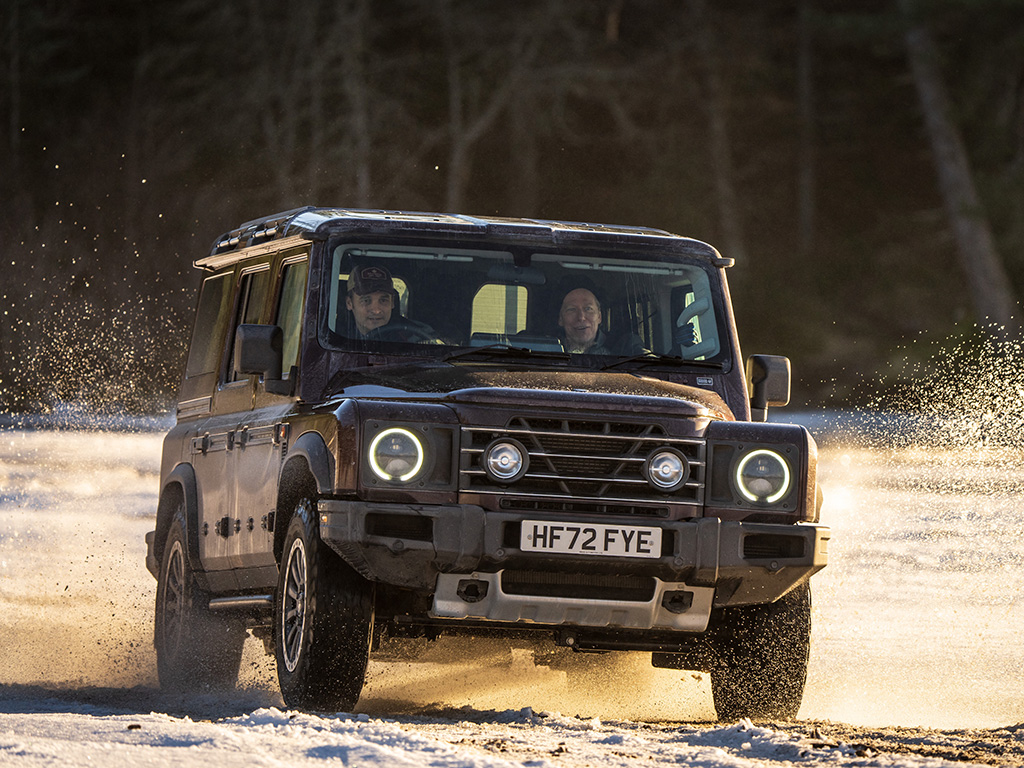


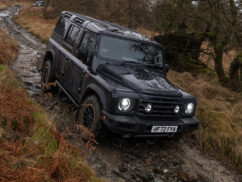

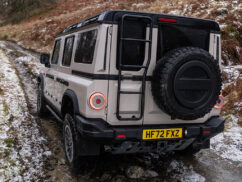



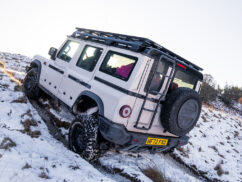
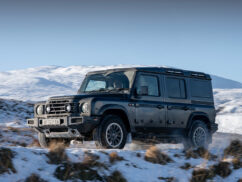

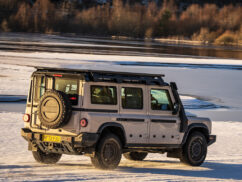

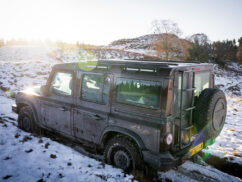



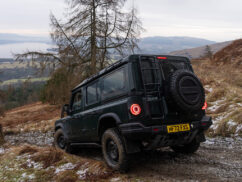
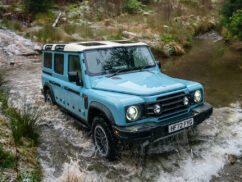





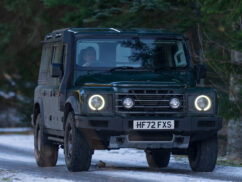


There are no comments. Be the first!